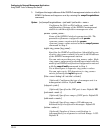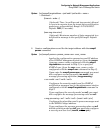
Configuring for Network Management Applications
Using SNMP Tools To Manage the Switch
Syntax: snmp-server host <ipv4-addr | ipv6-addr> <community name>
Configures a destination network management station
to receive SNMPv1/v2c traps, and (optionally) event log
messages sent as traps from the switch, using the
specified community name and destination IPv4 or
IPv6 address. You can specify up to ten trap receivers
(network management stations). The default
community name is public.
[<none | all | non-info | critical | debug>]
(Optional) Configures the security level of the event log
messages you want to send as traps to a trap receiver
(see table 13-1, “Security Levels for Event Log Messages
Sent as Traps”).
• The type of event log message that you specify applies
only to event log messages, not to threshold traps.
• For each configured event level, the switch continues
to send threshold traps to all network management
stations that have the appropriate threshold level
configured.
• If you do not specify an event level, the switch uses
the default value (none) and sends no event log
messages as traps.
[<inform>]
(Optional) Configures the switch to send SNMPv2
inform requests when certain events occur. See
“Enabling SNMPv2c Informs” on page 13-21 for more
information.
Table 13-1. Security Levels for Event Log Messages Sent as Traps
Security Level Action
None (default) Sends no event log messages.
All Sends all event log messages.
Non-Info Sends all event log messages that are not for information only.
Critical Sends only event log messages for critical error conditions.
Debug Sends only event log messages needed to troubleshoot network- and
switch-level problems.
13-20


















